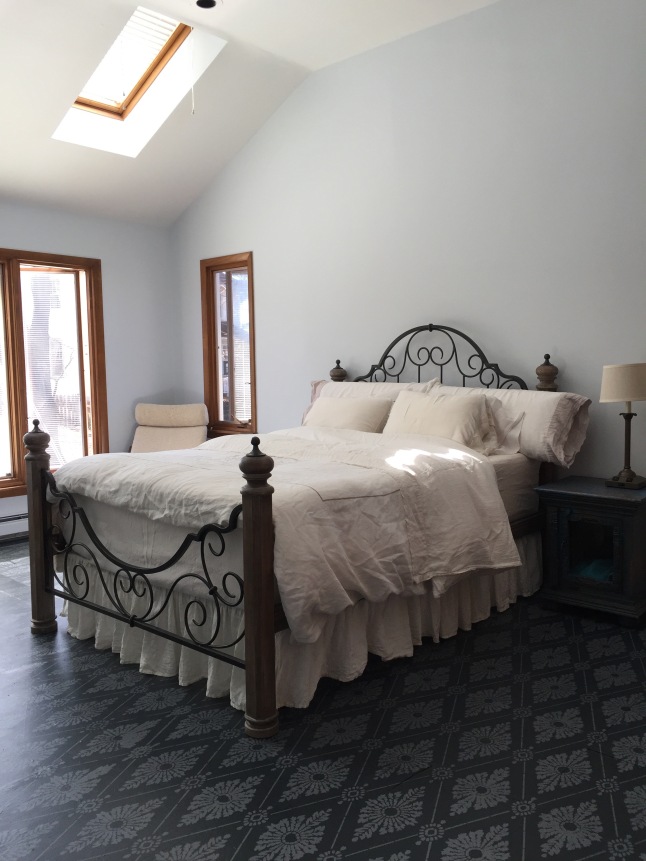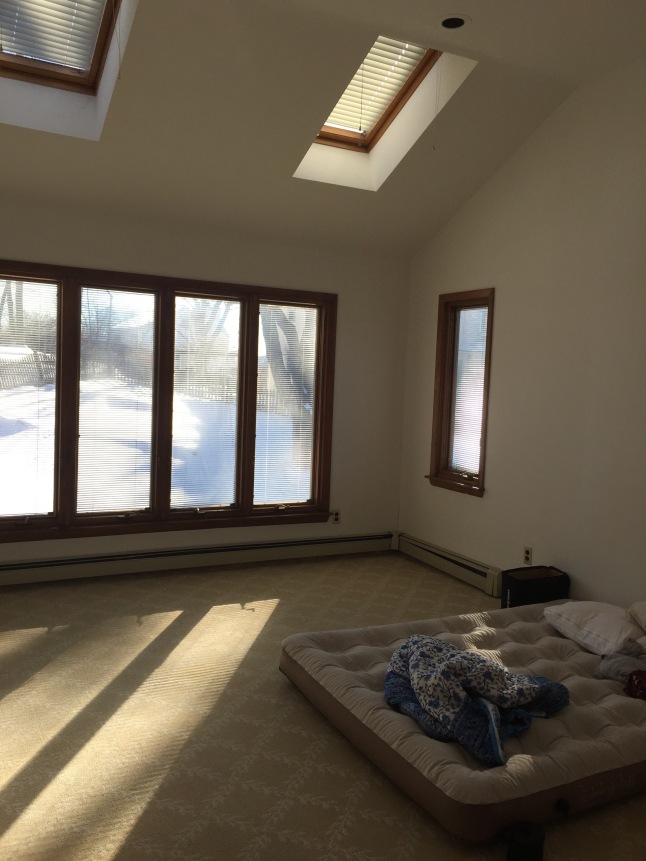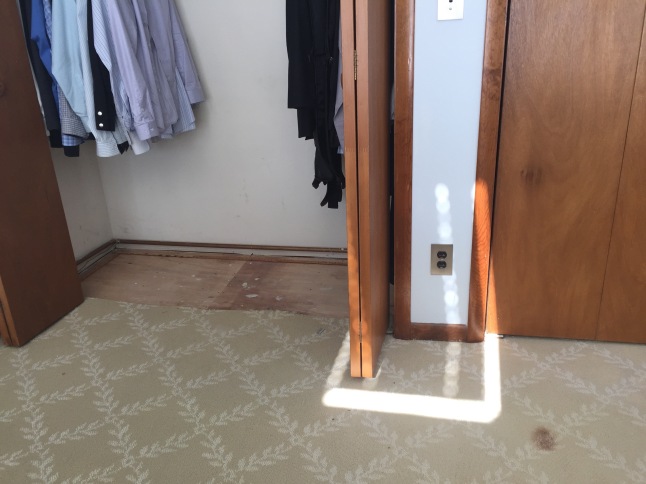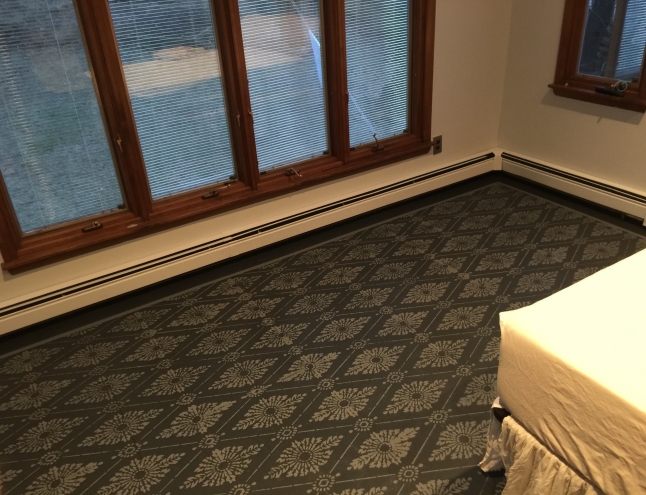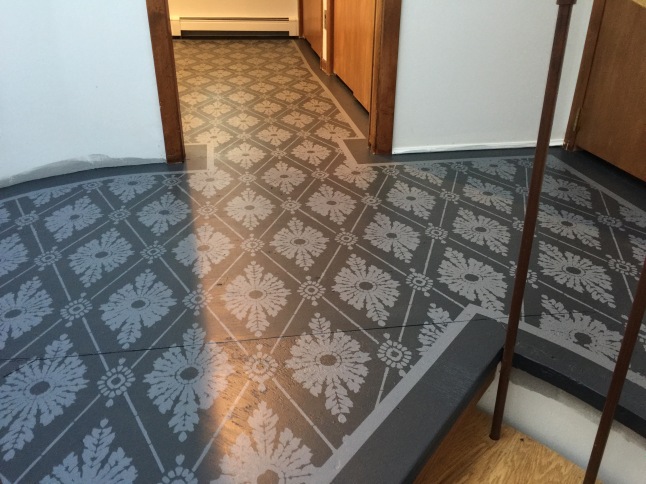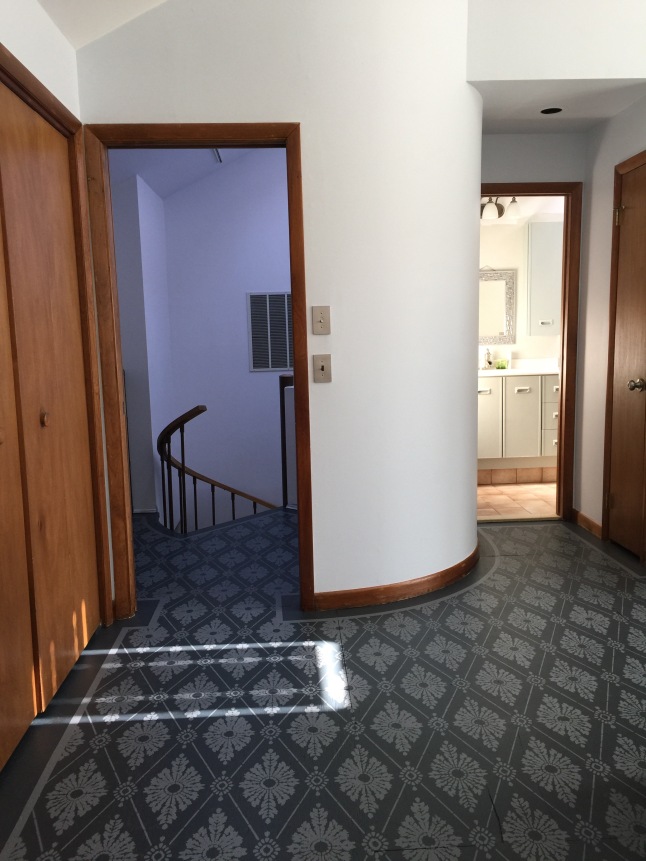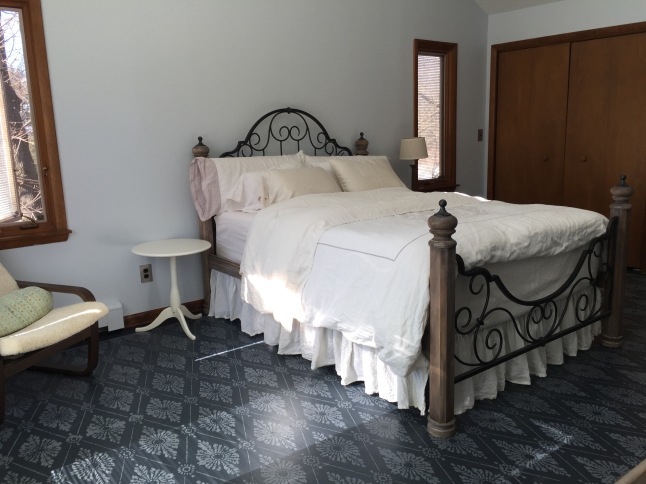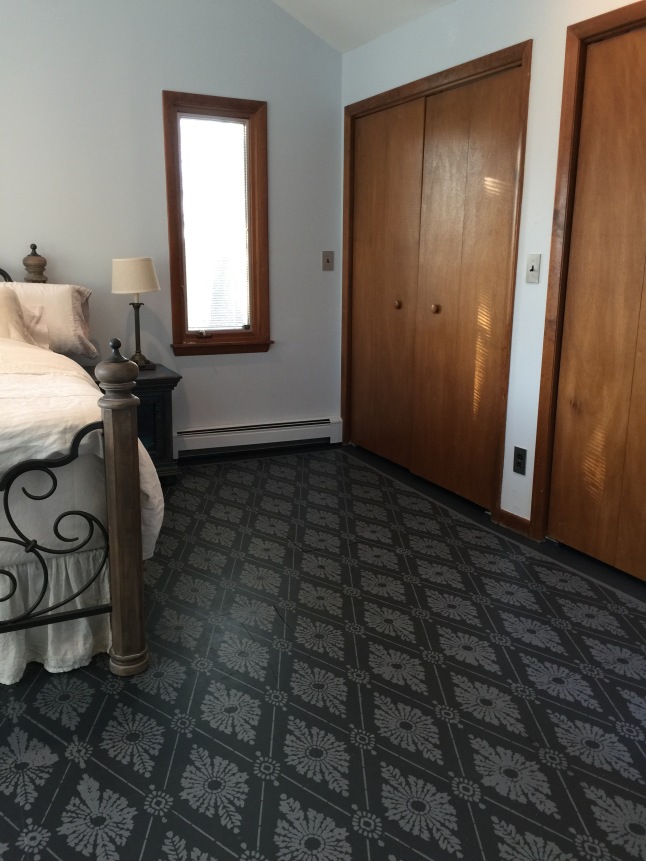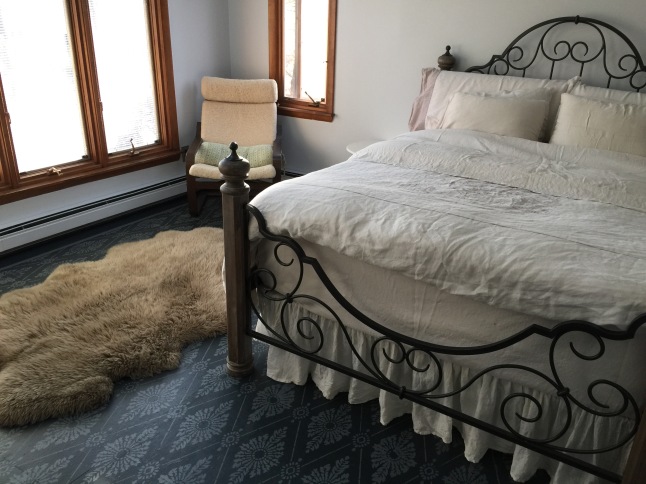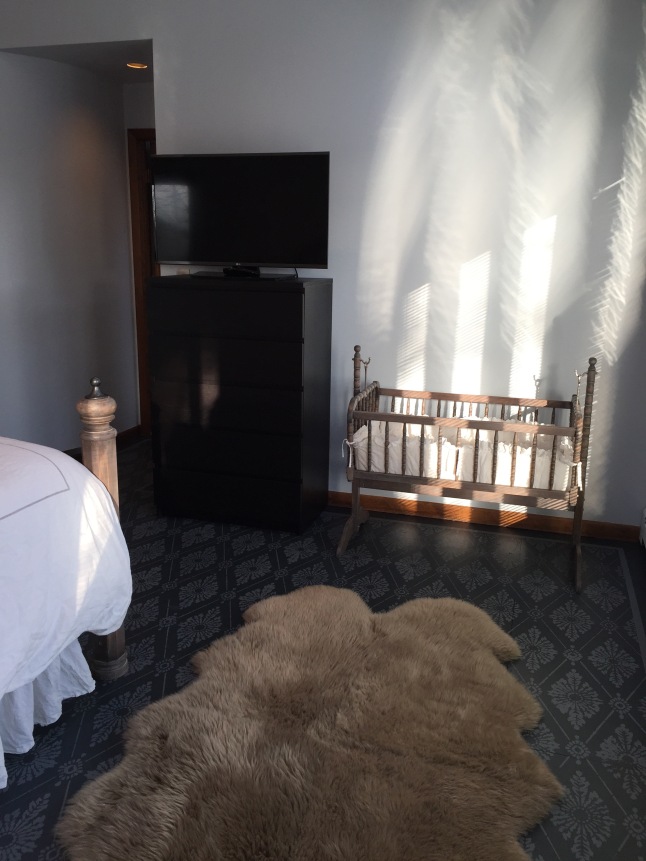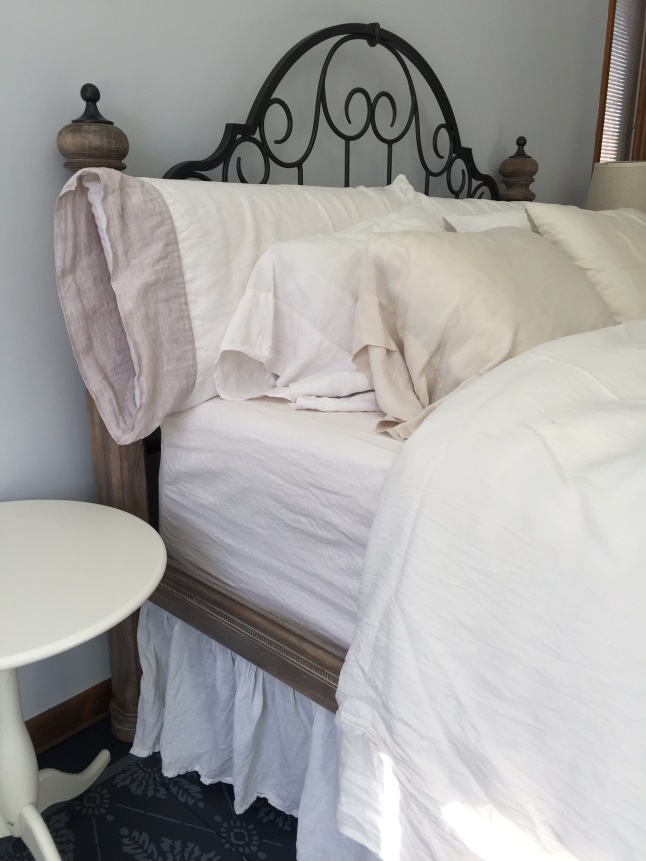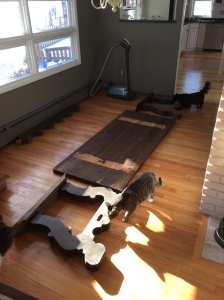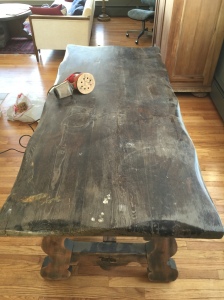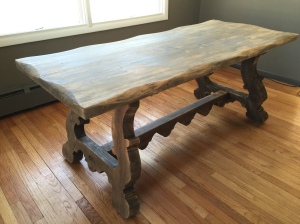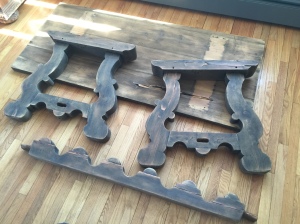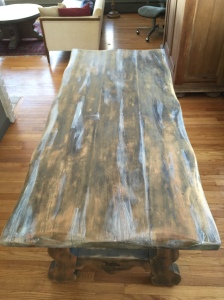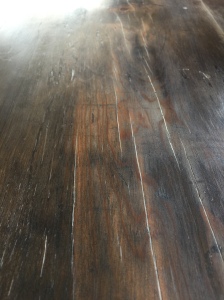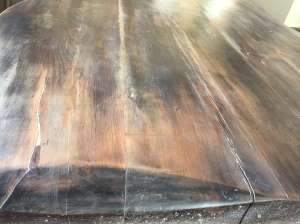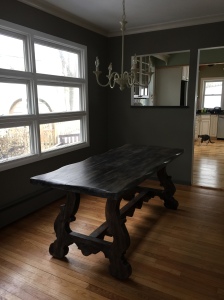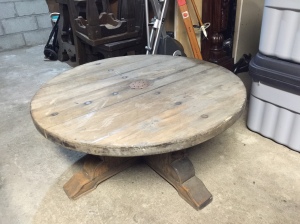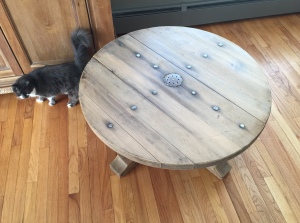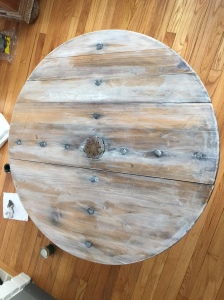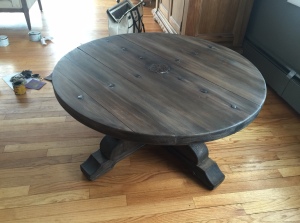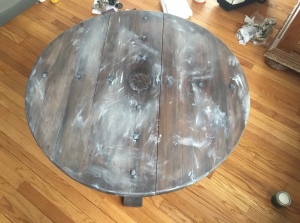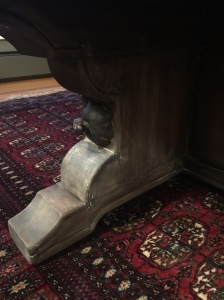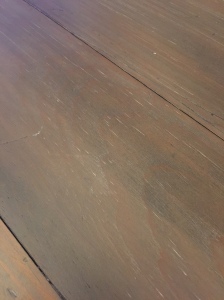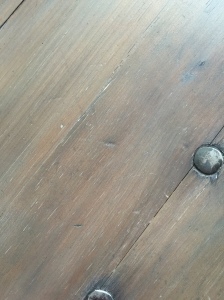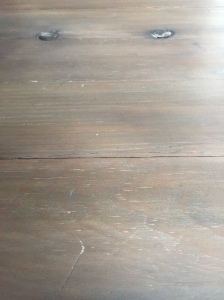Sometimes beaten up and mistreated furniture just cannot be saved, but sometimes a piece that looks almost certainly like trash can become a treasure with hard work and luck. When I brought home the dresser, that I hoped to make into a changing table and storage for Mini, it did not look promising. At all.
As I’ve written about before, I’d been keen to use this old dresser for Mini. It was in the guest room of our house when I was growing up, and it was one of the only pieces of family furniture that I ever liked at all. I took it to my first adult apartment and refinished it, but later I didn’t have a space for it, so it went into storage at the farm. Then it was kept in a damp basement for several years and was nearly destroyed. I still can hardly believe that I’ve managed to save it!
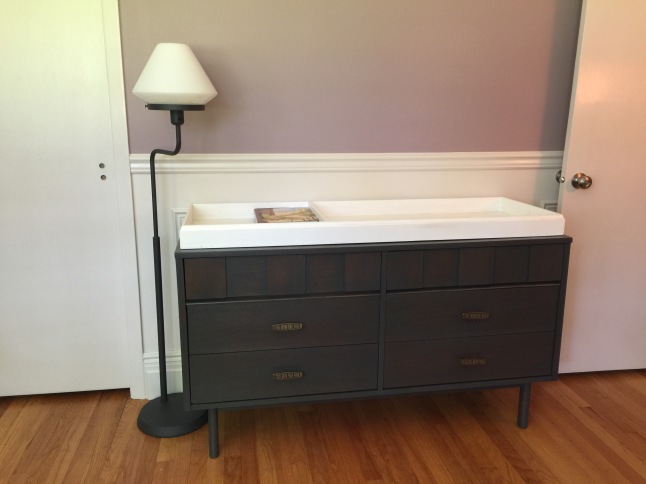
That is the dresser topper that I scored at the Restoration Hardware outlet for $20. It was really a lucky find for the price and that it fits so well. I hadn’t planned on using a topper, but it finishes the look and seems useful.
Here is the dresser when I picked it up from my Father’s basement:
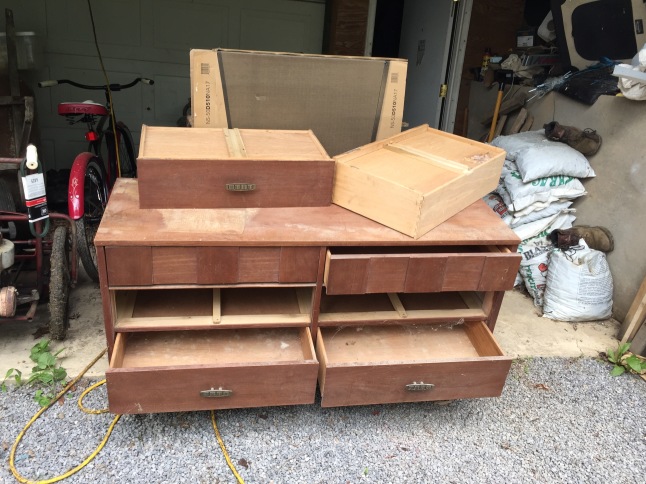
He had it airing outside in the heat for a day or two, but it was still warped and mouldy. It was a sad sight, but I thought it looked salvageable. Maybe. We don’t have a very good vehicle for transporting treasures, so my mother was kind enough to drive me home with the dresser. We’d planned it in advance, so I decided to go ahead and take it home figuring I could set it out for trash there if it turned into a disaster.
Soon I set about trying to clean it up and get it ready for repairs and staining or painting. Veneer was warped, separated, bubbling, and broken. It was covered with mould inside, and the chipboard back was beyond gross from moisture and mould. All the drawers were a bit stuck, but a few did not open or close at all. Check out some of the mould…
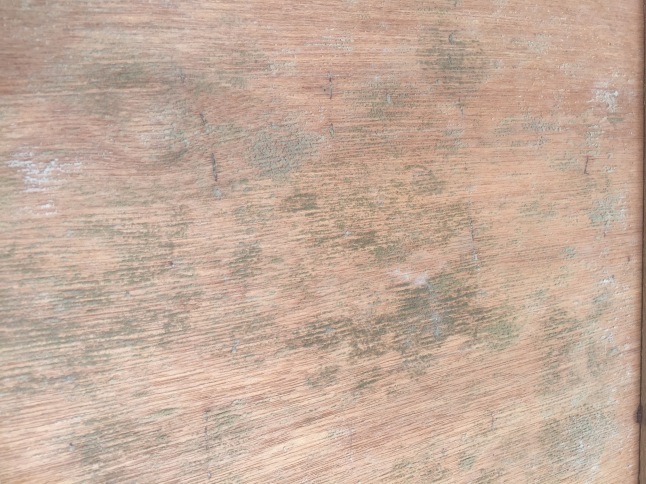
Photos did not adequately capture how bad the condition was, I think, and after really taking a look I was discouraged. At that point I decided to slather every surface with Citristrip and wash every nook. I’d deal with the effects of more water later, but I had to do something to clean it. Also, I tore off the back having deemed it too nasty to save.
It looks pretty decent in the photos, but it dried a complete mess. I was even more discouraged by now, and L suggested we toss it and buy something. However, I’d already done a lot of work and hated to spend a few hundred dollars for a similar dresser off Craigslist. Then I’d have to figure out a rental truck or something and go through the stripping ordeal again. (None of my searches produced anything available less than an hour or two away, and everything was a few hundred dollars. Bleh.) So, we carried it upstairs where I could continue work where it was clean and dry.
Thus began days and days of gluing. I have a handful of clamps and some scrap wood to hold things tight while drying, and I had to keep doing bit by bit. Besides, one can only glue certain portions at a time anyway. Every day I’d glue some section as soon as I woke up, and I’d do another round or two by the end of the day. Some parts only required a squirt of glue and clamping overnight. For the thinner veneer I had to use a pin to squeeze glue into the layers. The two bottom drawers practically disintegrated, and I had to carefully rebuild the plywood itself!
Some week or two later I finally was done glueing.
The original handles are pretty cool, I think, and they cleaned up fairly nicely. I waxed them to prevent any more corrosion. Usually I avoid brass/gold toned metals, but this should go perfectly with some little stamped brass covered tables that I have already.
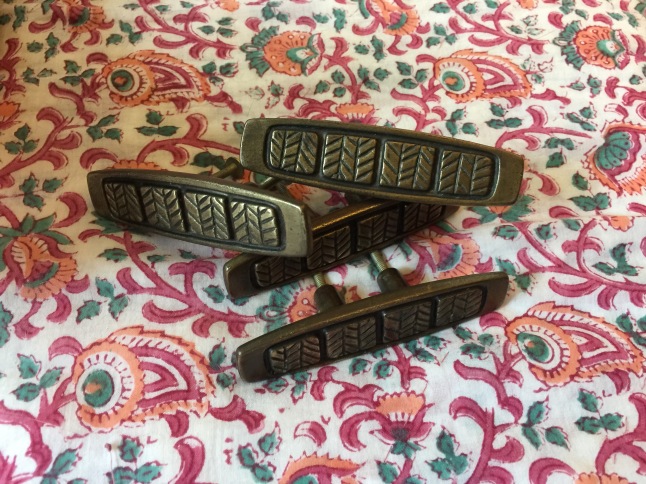
During the glueing process I had also been painstakingly sanding the drawers and rails so that they would slide smoothly and open properly. I nearly replaced the rails with drawer slides, but I didn’t want to deal with installing them or spend the money either. Luckily sanding and planing made a huge difference, and I am glad to have the original mechanism. It sure was a pain, but it helped that my sanding block fit perfectly in the groove on the drawers!
Next I nailed on a new back and filled in the missing portions of veneer with stainable wood filler. I had hoped to use stain and not resort to painting, and by now I thought that the veneer looked decent enough to.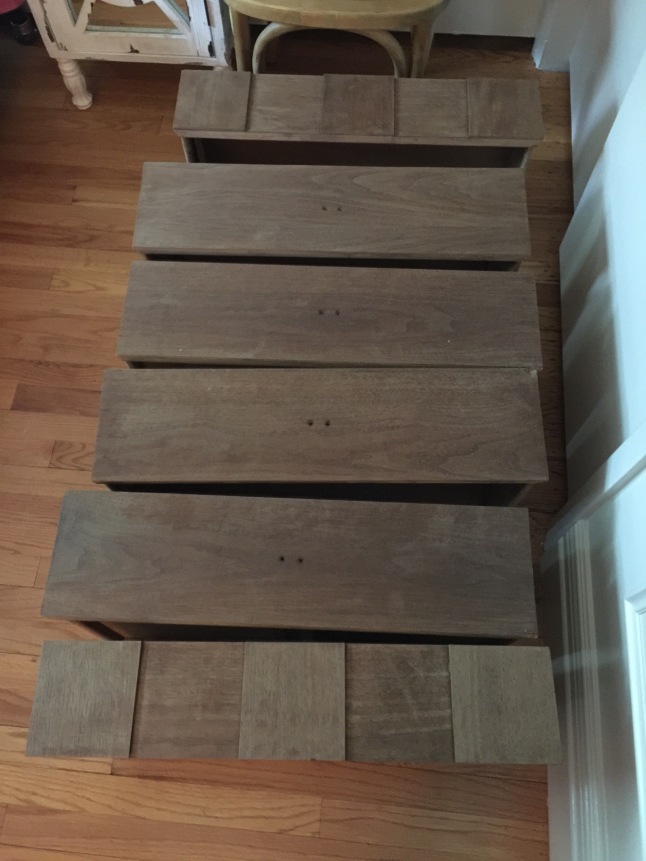
All ready for stain. You can see that one entire veneer strip was gone:
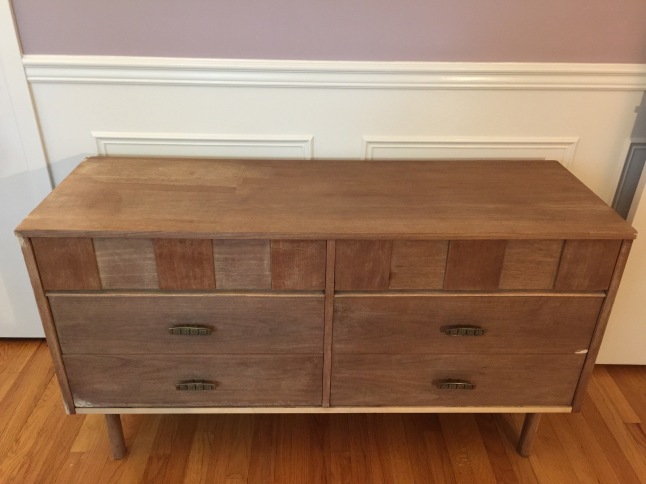
Choosing the stain was a tough decision. On the one hand I wanted a nice light pickled oak whitewash sort of look or especially classic grey, but I wasn’t sure the condition was suitable or how well I could get it to turn out. L prefers a really dark finish on furniture, so I considered ebony stain or doing a wax and stain treatment like our dining and coffee tables which are meant to look sort of Restoration Hardware. At the store I also saw neat colourful options, but I was too afraid of adding yet another colour to the room yet. (I’m full of regret about the purple-pink walls.) Carbon grey looked nice and became a contender too.
I agonised over the choice in the store and at home. L voted for the carbon grey, so I tried it out, and also the ebony, on hidden areas. The wood inside of the dresser was different, but I could see that ebony was not at all forgiving of any variations in tone. I suppose classic grey would have had the same limitation, and I went ahead with the carbon grey once L saw a photo and loved it. All along I had reservations, and even with it complete and looking good I still wish, just a little, that I might have chosen another finish. I do like it very much, but there is always the thought of what could have been if I went in a different design direction, you know?
All stained, including the hidden parts of drawers!
And clear coated with polycrylic:
L absolutely loves it and is nearly in disbelief that I made this happen with such a piece of junk. I’m quite pleased with it also. Yesterday I stripped the lacquer off of the rocking chair, and I’m pretty sure I’ll use the same carbon grey stain for it. The only reason I might not is if the fabric doesn’t go well with it, but even then I’m more likely to get new fabric. The wood of the frame will not cooperate with the wax/stain Restoration Hardware inspired treatment, but carbon grey will work very well and match the dresser. Anyway, that is the next project calling my name even though I should really be doing trim paint and a few other things first instead. Yet I’ve begun to work on it to take advantage of the creative energy, because I’ve been feeling very tired and not motivated lately. Then today I was up at 6:30, so I mowed the lawn and removed the storm windows from Mini’s room in order to repair them and the windows. I’ll replace the screens and paint this week, and I already scraped and glazed one of the three windows before it became too hot this morning.
I didn’t think to take a before of the storm windows and their metal screens, but here is a shot that shows them well enough. You may see a difference compared to the smaller window to the right, because I took it apart last fall to replace the screen with modern stuff. It is less noticeable and looks far nicer in my opinion, but I wish I could have made the metal frame look better too. I did my best with steel wool but it didn’t make much difference. Perhaps one day we will buy wooden storm windows to replace them or even have the original windows switched out. I HATE to use modern windows when the old kind look far, far more lively and attractive, and can be made efficient with storms, but the truth is that these were never good quality and aren’t in great shape now. Maybe we can find replacements that keep the style and upgrade the quality? I’m sad that a few other windows were replaced with very generic ones by the pervious owners. It changes the look badly in the front of the house.
Before of the storm windows:
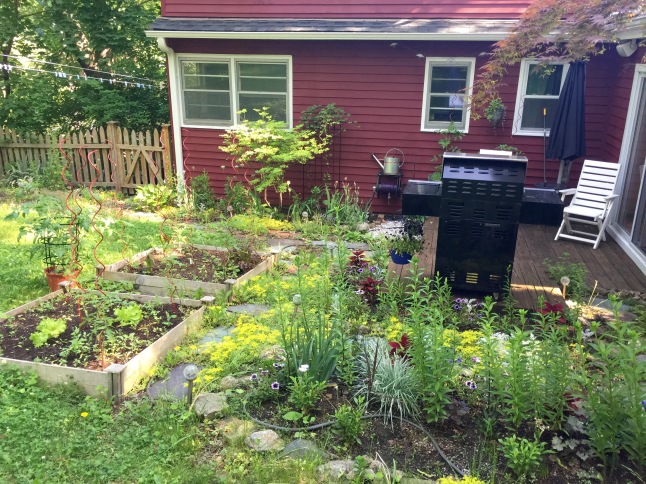
Right after removing the storm windows. Dirty, but they sure are more attractive without the sturdy and practical metal storms. I’d leave off the inserts for the summer if I could, but they also provide the screens:
Scraped and looking like complete crap:
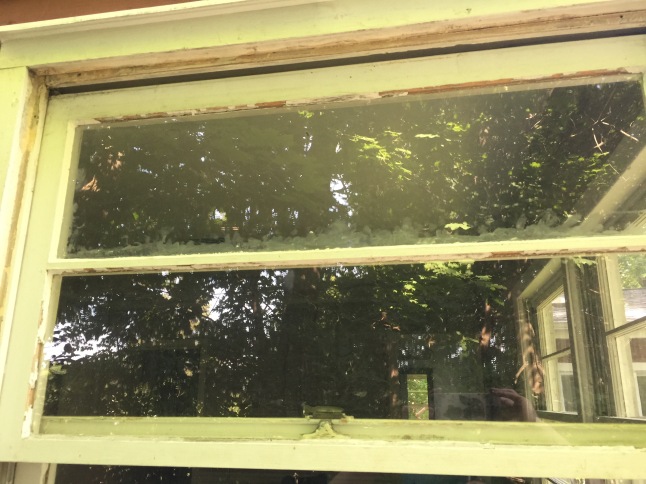
Beginning to glaze:
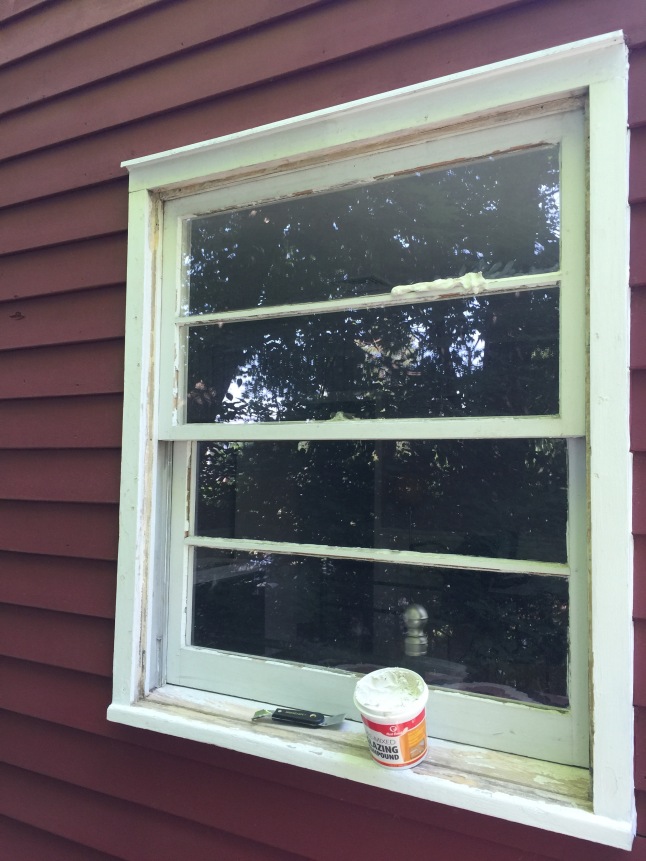
Finished glazing one whole window! Of course it still needs to be cleaned up and painted, but I’d say it has improved already:

The glazing went much better than the first windows that I worked on last fall. Perhaps warmer weather improves the flow of the glazing compound? It felt like I’d really improved my technique since it went so quickly and easily, but I’m guessing it was really the heat. 😀 In the fall I didn’t quite complete the job, but I think I’ll get to those windows too.
Today I made some changes and updates to my lengthy to-do list, and here it is in case you would like proof of my insanity…
13th of June to-do list:
Front of house
-Patch broken front steps.
-Paint foundation a more pleasing shade.
-Buy new light fixture and install with sensor bulb.
-Last bit of patching.
-Last bit of painting.
-Wash windows (uninstalling and reinstalling storms. Make screens??)
-Finish glazing windows
Mini’s room
-Brush final trim coat on nursery panelling.
-Remove storm windows
-Disassemble, and replace screens.
-Scrape and glaze: (One,) (two,) (three.)
-Paint exterior windows.
-Reinstall storm/screens.
-Remove security crap from windows.
-Patch.
-Paint windows (interior.)
-Change light switch and cover plate.
-Buy floor lamp.
-Buy and install shades. Or make some.
-Have crib sandblasted and finished or do clear coat.
-Attach casters to crib. Create replacement hardware.
-Attach casters to walker and assemble.
-Bring dresser from Dad’s and refinish.
-Sew Kirghiz felted carpet to a dowel for wall-hanging.
-Strip rocking chair.
-Sand rocking chair.
-Stain rocking chair.
-Reupholster rocking chair and sew pillows.
-Fix leaky sink valve.
-Set up furniture, wall art, and organise.
Main living areas and stuff
-Replace certain outlets, switches, and cover plates.
-Paint dining/living windows.
-Scrape messy paint.
-Finish painting kitchen trim and panelling
-Repaint living/dining ceiling.
-Apply sealant on entry and hearth tile/grout.
-Sew back of sofa.
-Staple cambric.
-Sew pillow covers.
-Finish sanding dining chairs.
-Stain and wax chairs.
-Paint and Mod Podge antique travel chest.
-Touch up kitchen chairs and hoosiers.
-Repair coffee table.
-Repair and sand end table.
-Paint to match coffee table.
LATER:
-Reupholster recliner.
-Reaupholster little round chair.
Exterior
-Stain east side of house.
-Stain or hire west side of house.
-Powerwash patios and chairs.
-and paint rusty table with hammered finish.
-Stain patios.
-Permanently attach umbrella to deck with bolts.
-Powerwash fence.
-Stain fence.
Unfinished part of basement
-Finish painting walls.
-Rewaterproof spot on floor.
-Touch up floor paint.
Organisation
-Organise storage area.
-Organise basement.
-Organise Garage.
-Organise attic.
-Organise kitchen.
-Organise sewing room.
-Organise baby items in closet.
-Organise master closet.
-Have yard sale.
Dressing room and spiral stairwell
-Touch up ceiling paint.
-Shift PAX and MALM to left.
-Patch.
-Brush edges.
-Roll walls.
-Paint trim.
Sewing room
-Remove sewing room door.
-Mark and chisel hinge mortises.
-Mark and drill door knob. -Install knob.
-Hang door.
-Paint door.
Other kinds of non-house projects
-Remake lamp shade for hanging lamp in Mini’s room.
-Remake a play mat and arches for hanging toys
-Stain and make a busy board for Mini
-Sew dresses for myself; light coat for myself and Mini; dresses, pants, and quilted coats for Mini; a small quilt; sew some soft toys; …
-Crochet or knit sweaters, hats, pants, and booties for Mini
-Make a mobile?
Pushed to later:
Master
-Caulk.
-Paint master ceiling.
-Touch up master bath vanity.
-Recoat walls.
-Poperly hang mirror.
-Install tub trim kit and drain.
-Install shower trim kit.
-New switches, outlets, and cover plates.
Storage room (now office)
-Remove stored items from storage/office.
-Rip out carpet and pad.
-Remove panelling.
-Patch and caulk.
-Prime.
-Brush paint.
-Roll walls.
-Paint sewer pipe with hammered finish.
-Paint ceiling.
-Change light fixtures.
-Change outlets and cover plates.
-Frame the two cinderblock walls
-Install foam insulation panels
-Drywall or panelling…
-Prime and paint newly insulated walls
Media room
-Get rid of giant speakers and console.
-Mount TV and sound bar.
-Rip out crappy laminate.
-Remove trim.
-Install DryCore.
-Lay insulating underlayment.
-Install vinyl planks.
-Reinstall trim.
-Paint touchups. (I did re-paint a lot but need to finish since I ended up using a new gallon that doesn’t match perfectly.)
-Arrange furniture.
-Paint or replace stained ceiling tile. (or ideally change to 2×2′)























